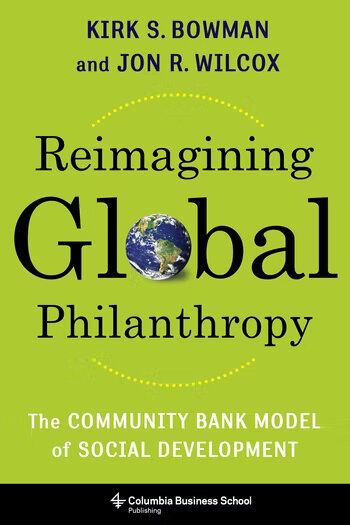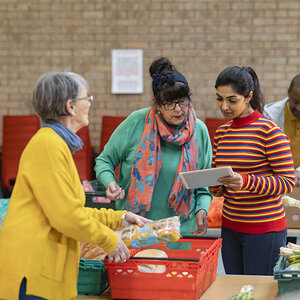Reimagining Global Philanthropy: The Community Bank Model of Social Development
The tradition of philanthropy — of giving to those who have “less” — is an old one. The desire to do good and make a positive impact has driven some of the most powerful social movements, innovative technology, and inspiring advocacy of the last several decades. Charity is a very human act; as long as inequity exists in the world, there will be those in positions of privilege and power seeking to address that inequity. But in today’s globalized society — where money can break down even the toughest geographical barriers and allow the wealthiest among us access to the most remote, estranged, and yes, impoverished communities — good intentions are simply not enough to create effective philanthropic practices. So how do you make philanthropy efficient? What giving models actually generate “the most bang for the buck” for both donors and grantees? These are the questions Kirk S. Bowman and Jon R. Wilcox attempt to answer in Reimagining Global Philanthropy: The Community Bank Model of Social Development.
Bowman and Wilcox are a liberal college professor with a focus on international relations and development and a conservative community banker, respectively, and co-founders of the nonprofit Rise Up & Care, and the combined expertise and perspectives of these two old friends make for a very evenly written, balanced theory and accompanying narrative. Good philanthropy requires both deep compassion and an understanding of the financial realities of charitable giving and nonprofit operations. Despite the frequent differences in their points of view, Bowman and Wilcox have used their individual strengths to develop their compelling community banking model of philanthropy.
And that is the crux of the book: that to see the best returns and supporters, grantees, and clients the happiest, philanthropists should consider using a community banking approach to their giving, especially on a global scale. Today’s philanthropists have more access to the Global South than ever before, and there is growing interest in supporting good work there, but this interest is often in low-income countries the donors know little to nothing about, and that’s where things get much dicier.
For example, a wealthy couple vacationing in Cambodia are struck by how far the dollar stretches and aghast at how little the average local resident lives on; a college student studying abroad in Kenya is inspired by the struggles of her working-class host family; or a stockbroker on a mission trip with his congregation to the Dominican Republic sees first-hand that he has the money to tangibly change the lives of the poorest families who seek assistance from their local churches. They mean well, but all too often, in their passion to help communities that they have seen suffering, these philanthropists pursue paths that end in abandoned projects, wasteful spending, and clients that are no better off than they were before. Surely there must be a better way to aid those in need.
As both Bowman and Wilcox point out, criticizing current processes is easy; it’s much more difficult to suggest a better solution. Luckily for us, they’re up to the job. The community banking model of philanthropy they suggest is the result of decades of involvement in the worlds of finance and international development, years of observation of the successes and failures of startups in both the nonprofit and private sectors, and analysis of data from their experiences with Rise Up & Care, which invests in grantee partners in poor communities and then promotes them by producing documentary films about their work. While the community banking model technically describes a method by which donors can identify smart grantees to invest in, the model Bowman and Wilcox promotes is a two-part process — and the first part may be the hardest one for wealthy Samaritans to accept.
Before spending a single dollar, the authors argue, donors must do as much as they can to remove themselves from the equation. There is a disturbing tendency in international development to believe those in the Global North are not only wealthier but also better than those of the Global South: We’re smarter, we’re more technologically advanced, we’re more ambitious; we can make things happen when others (i.e., the destitute and disenfranchised) can’t. Even if they’ve only spent two weeks in a place they wish to aid, where there’s a will, there’s a way, right? Bowman and Wilcox call this the “Philanthropist’s Burden,” and laid out like this, the inherent racism of such bias becomes pretty quickly clear. No matter how well-meaning, no rich foreigner thousands of miles away will ever be able to understand the problems or come up with solutions better than the people living there. It is far more efficient to find local changemakers who are serving as role models and leaders in their own communities and invest in their projects.
Once donors accept that they’re best suited to the role of “sidekick,” the next step is to identify local nonprofit leaders to invest in. This is where the community banking model comes into play. Commercial community banks have been vital, stable money-lending institutions for thousands of years. Like other microfinancing models, community banks exist largely to help lift the impoverished out of poverty, but the additional criteria they require to approve a loan — most frequently, those based on borrowers’ reputations within the community — helps their clients avoid predatory money lenders, and those clients default on their loan payments much less often. If community bank loans have such high rates of success, then it stands to reason that grants made with the same criteria should perform equally well. The only difference is that the recipients of those grants would not be expected to repay those loans, even though they will still be expected to meet certain metrics.
Bowman and Wilcox identify the relevant characteristics a community bank seeks when deciding whether to give out a loan as: character (the mental and moral qualities distinctive to an individual), capacity (the ability of the borrower to repay the loan), capital (the amount of personal investment in the business venture), and conditions (the intended use of the funds and how the borrower intends to pay them back). These qualities enable community banks to assess the risk of each potential borrower and lend only to those most likely to pay back their debt. While recipients of philanthropic funding wouldn’t be expected to pay their donors back, strong nonprofit leaders who demonstrate those same four characteristics are likely to spend their grant dollars in ways that maximize impact and minimize waste. While the returns won’t be in cold hard cash, giving to charities is still an investment. Donors should feel confident that their investments are being spent wisely by leaders with a track record of success. No matter how you look at it, it’s a model that makes sense.
If there is one flaw in the book, it’s that it can sometimes feel like a commercial for Rise Up & Care. Too often, the reader is asked to put down the book to watch a trailer for one of their documentary films (or the film itself) — but this is a quibble. While Bowman and Wilcox readily admit that their community banking model may not be the only viable approach to global philanthropy, it is certainly a compelling one. Perhaps, if more people follow their example, we will soon see a wave of maximized efficiency and impact in philanthropic funding in support of communities around the world.
Audrey Silverman is a fundraising professional working in the Jewish nonprofit sector.








